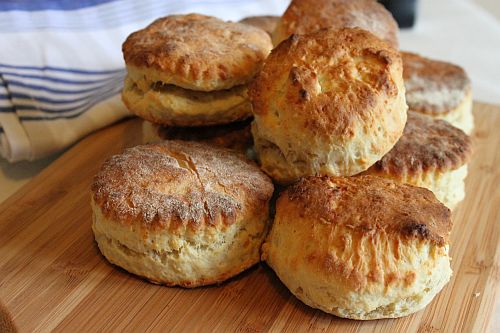
Well, in my family, we’ve always called them scones as in “John” and I was surprised to hear someone pronouncing them as in “cone” for the first time. A quick search on wikipedia assures me that the “cone” pronunciation is recognised but it seems that the Scots – who invented these little beauties in the first place – pronounce it as in “John.”
But what’s in a phonetically ambiguous name, anyway? Even if scones were called “garst-boogers” they’d still taste awesome.
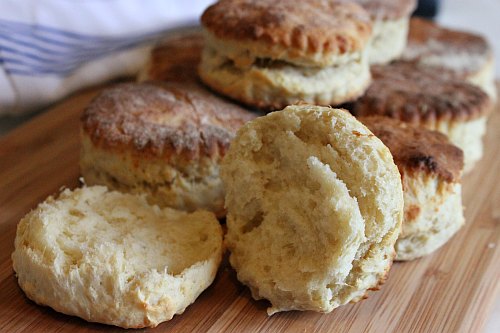
The regular readers among you may be aware of my somewhat calamitous baking past. I know now, especially after nearly two years of having this food blog, that a major MAJOR ingredient in cooking is confidence. Baking still makes me nervous, as mistakes made while cooking can usually *usually* be saved.
Baking is not so forgiving. So when I set about baking something for the first time, I need to know that the recipe I’m using is a reliable one that I can trust, one that will hold my hand while I take intrepid steps into dough-land.
Which is why I was so delighted when Nessa Robins answered my call for help on Twitter in finding a good scone recipe.
Nessa runs a wonderful blog called Nessa’s Family Kitchen, where she shares the recipes that she makes every day with her young family of four (four!) boys. She also runs Killachonna Cookery School, specialising in teaching little ones how to make their way around the kitchen.
I knew she was the right recipe-hand-holder for me as I am a total BABY when it comes to baking! I tried her scone recipe and they turned out 100% perfect, which for me is a very big deal indeed.
I added a little bit of parmesan to her recipe, but it was only about 25g and, although it wasn’t enough to get the flavour across, it was enough to give them an ever so slightly savoury hue. Which meant that they could work with a bit of cheese and chutney as equally well as some clotted cream and jam. NYOM.
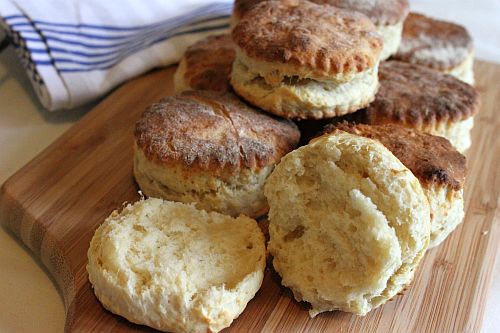
What you need for Nessa’s Family Kitchen scones (makes 10 – 12)
450g self-raising flour
Pinch of Salt (which I forgot but I guess my added parmesan compensated for that)
25g caster sugar
85g cold butter
1 large egg
225ml milk
For the glaze (which I forgot. See what I mean about a flustered baker?! I’m terrible!)
A bit of egg whisked with a little milk (I think milk works just as well on its own in case you don’t want to use another egg)
Pre-heat your oven to 200 degrees C/ Gas Mark 6.
Start off by sieving your flour and caster sugar into a large mixing bowl. Cut your butter into smallish cubes.
If like me, you have hot hands that don’t make for baking, you can use a food processor to combine your flour and butter. If you have a more delicate paw than myself, then you can rub the butter into the flour until it’s all combined and you have a sort of crumb texture.
I find the food processor really, really useful here, because it takes like 1/8th of the time and you don’t have to worry about your butter melting which could lead to major drama and kitchen meltdown! And that’s not what we want.
Beat your egg into your milk.
Now (if using food processor) return your flour and butter mixture to your big mixing bowl. Make a sort of well with a wooden spoon and pour your milk and egg mixture into this space, mixing everything around with a wooden spoon until a rather wet and sticky dough is created. Don’t panic! It’s supposed to be a bit wet. It’s all going to be fine.
On a floured surface, plop out your dough and knead it, but not too much, as Nessa says that will toughen the scones. You can sprinkle a little bit of flour over the dough if you think it needs to be less sticky, but it should be perfect once it’s had a nice massage.
Now you want to roll it out. I always use cling film when rolling any dough. I put it over the dough and then flatten the dough with a rolling pin – the cling film stops the dough from sticking to the pin. It’s very clever.
Roll out your pastry and using a little perforated cutter, cut out as many scones as you can. Now roll up the excess dough and cut out some more. Repeat until you ain’t got no dough left.
At this point, you can glaze your scones with your milky egg mixture.
Pop your scones on a buttered baking sheet, not over-crowding them, and bake in your oven for 10 to 12 minutes. My cutter was quite small so I ended up with around 15 little scones, which I baked in two batches.
Take your scones out and let them cool slightly on a rack, but they’re pretty much ready to go and be enjoyed.
Best served warm!
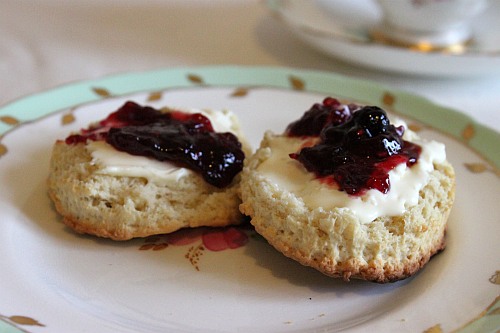
UPDATE
Later in the week, I used this BRILLIANT Delicious Magazine recipe for Spring onion, bacon and cheese scones which we scoffed with cheese and chutney. Amazeballs!
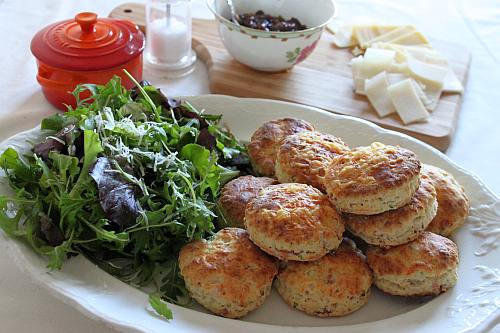
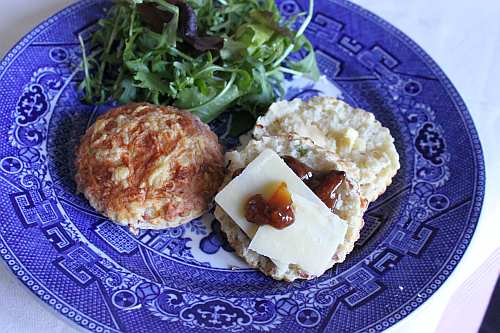
TUNE
I pretty much cannot stop listening to the Jamie XX remix of Adele’s Rolling In The Deep, the original version of which appears on Adele’s latest album 21, produced by Rick Rubin. The original version is cool but this remix is amaaaaazing. Love it.
Rolling In The Deep – Adele (Jamie XX remix) – on The Hype Machine
January 13, 2011 at 12:44 am
Mmmm! Fresh baked gasrt-boogers are the best. Nice to see you’re feeling a little more confident about baking.
January 13, 2011 at 11:06 am
Thanks Joanna! I’m definitely getting there. Although I’m still a little hysterical. But much better than this time last year!
January 13, 2011 at 9:28 am
WhoHa! Aoife those scones look divine. The photos are making me drool and it’s only breakfast time!!
January 13, 2011 at 11:07 am
Thanks Gillian They were pretty tasty – especially with the Cornish clotted cream I picked up in M&S. ZNOMZZZZZ!!!
They were pretty tasty – especially with the Cornish clotted cream I picked up in M&S. ZNOMZZZZZ!!!
January 14, 2011 at 3:43 pm
Scones look good, I have a kind of mental aversion to baking any scones sans fruit although I am intending to try Carmel Somers (from the wonderful http://www.thegoodthingscafe.com/) recipe one of these days, her seeded brown scones rock!!
January 15, 2011 at 11:38 am
Love your photo of the platter – very nice – great light too!
January 16, 2011 at 1:20 am
Thanks Lucy! Natural light is always the best Those savoury scones were AMAZEBALLS. Everyone must make them and give them to everyone they love. SO GOOD!
Those savoury scones were AMAZEBALLS. Everyone must make them and give them to everyone they love. SO GOOD!
January 17, 2011 at 3:19 pm
It’s funny, because there’s a place in Scotland called Scone where, historically, coronations took place; it’s where Macbeth is coronated in the play.
We saw “The King’s Speech” last night, and there was mention of Scone: they pronounced it like “skoon”.
A few months ago, Anna was on the baking buzz, and she made some amazing savoury muffins. I’ll try to reinvigorate her love of baking and point her in the direction of this post for inspiration!
January 18, 2011 at 11:36 am
Ahh scooon – maybe that’s the original pronunciation.
I love savoury muffins so much – there were some in Hugh F-W’s Guardian column a few months back, yellow courgette muffins. I think I saved the recipe – hope I can find it!
But honestly, you should try those savoury scones from Delicious Magazine linked to above, sooooo good. And very simple to make!
January 18, 2011 at 2:18 pm
Yeah, it was those ones! Boy, were they good.
Okay, then I’ll consider myself on a mission to get her to make those. I, like you, fear baking.
January 19, 2011 at 11:07 am
Luck-eeee! I think I remember you telling me about them at the time ZNOMZ!
Baking is scary (aieieieieiiiiiii!!!!) but I’m feeling a helluvalot better about it now after throwing myself in the deep end. Going to try to make my own flavour combos in savoury muffins tomorrow – wish me luck, my friend!
January 19, 2011 at 12:36 pm
Ha, I’m on to you, Ben! Your time has come to bake, you big manly meat cooker, you. We will make savoury scones TOGETHER as a TEAM, yes?
Sweet scones make my teeth hurt but freshly baked hot cheese scones with loads of butter are about as close to heaven (and clogged arteries) as one can get.
Thanks for the inspiration Eefs. xx
January 20, 2011 at 10:44 pm
C’MON BEN! GET YOUR BAKE ON!
Pingback: Nervous Baking Frenzy « Insane Ramblings
March 25, 2011 at 3:06 am
Thanks. http://wp.me/p1fsVD-kf
Pingback: Scones in this photo? Recipe? « Calogero Mira, Food and Recipes
Pingback: Donal’s Lemon Drizzle Cake « I Can Has Cook?
September 19, 2013 at 11:38 pm
It’s just the thing for people who have got plane tickets
and merely require an area. So if you go this route it is
definitely better to contact your accommodation before leaving for
your trip to make certain you’ll hold the right amount of beds that you will need for your trip.
Especially for travelers traveling with their spouses or making usage of their families,
the all-inclusive vacation is often a good way to make certain all of the cost
is covered, and, perhaps much more important, an incredible way of preventing fighting about money during the vacation.